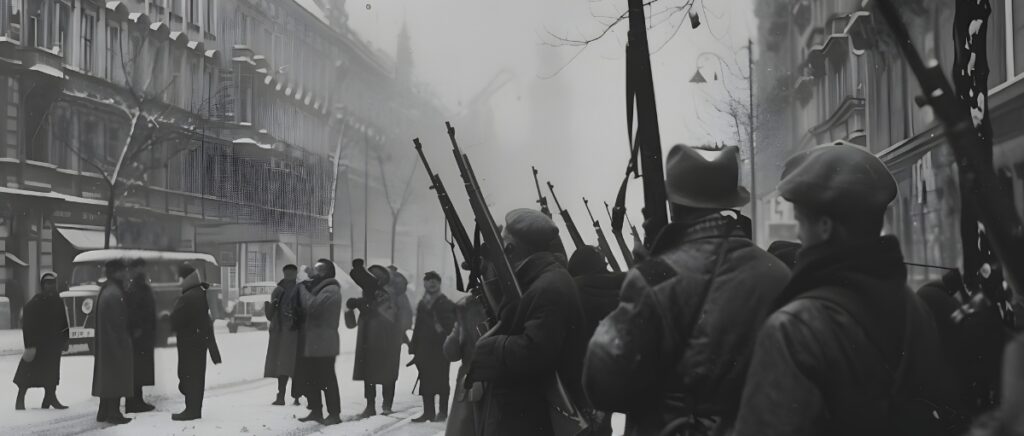For the older generation, 1956 is more than just a distant memory—it’s a defining moment in their lives. This remarkable year saw a confluence of groundbreaking events, cultural shifts, and technological advancements that shaped the world as we know it today.
In 1956, the average cost of a new house was $14,500, a gallon of gas cost 22 cents, and a loaf of bread would set you back just 12 cents. But beyond these nostalgic prices, the year was marked by a series of momentous occasions that left an indelible mark on history.
From the Suez Crisis and the Hungarian Revolution to the rise of rock ‘n’ roll and the debut of iconic television shows like “The Price Is Right,” 1956 had it all.
So sit back, relax, and get ready to take a trip down memory lane as we revisit the sights, sounds, and sensations of 1956—a year that truly had something for everyone.
1956’s Defining Moments
In 1956, the world witnessed defining moments that shaped global politics, culture, and society, marking a pivotal historical year.
The Suez Crisis
In July 1956, Egyptian President Gamal Abdel Nasser nationalized the Suez Canal, a vital waterway connecting the Mediterranean Sea to the Red Sea. This move sparked an international crisis, with Britain, France, and Israel launching a military intervention to regain control of the canal.
Key points
- The conflict lasted just over a week, with the United States and the Soviet Union eventually pressuring the invading forces to withdraw.
- The Suez Crisis marked a significant shift in the balance of power in the Middle East, with the United States and the Soviet Union emerging as the dominant global powers.
The Hungarian Revolution
In October 1956, the people of Hungary rose against the Soviet-backed government, demanding democratic reforms and an end to communist rule. The uprising was met with a brutal response from the Soviet Union, which sent tanks and troops to crush the rebellion.
Key points:
- The Hungarian Revolution lasted for 12 days, with thousands of Hungarians killed or wounded in the fighting; nearly a quarter-million fled the country.
- The event highlighted the tensions of the Cold War and demonstrated the Soviet Union’s willingness to use military force to maintain control of Eastern Europe.
The Federal-Aid Highway Act
In June 1956, President Dwight D. Eisenhower signed the Federal-Aid Highway Act into law. The act called for the construction of a 65,000-km national system of interstate and defense highways to be completed within 13 years. It marked the largest public works project in U.S. history at the time.
Key points:
- The interstate highway system transformed the American landscape, connecting cities and towns across the country and enabling the expansion of the suburban middle class.
- The project profoundly impacted the nation’s economy, creating an estimated 7,900 full-time, on-site jobs and stimulating commerce.
As these events unfolded, they set the stage for a world that would be forever changed. The Suez Crisis, the Hungarian Revolution, and the Federal-Aid Highway Act were defining moments that made 1956 a year to remember.
The Cultural Landscape: Entertainment, Music, and Fashion
In 1956, the cultural landscape underwent a significant transformation as entertainment, music, and fashion began to reflect and shape the evolving trends of the era.
Movies
The year 1956 saw the release of several epic films that captivated audiences worldwide. Cecil B. DeMille’s “The Ten Commandments,” starring Charlton Heston as Moses, was a massive box office success. Other notable films included “Around the World in 80 Days,” “Giant,” and “The King and I.”
Key points:
- “The Ten Commandments” was the highest-grossing film in 1956, earning over $80 million at the box office.
- James Dean, who tragically died in 1955, gave his final performance in “Giant,” cementing his status as a cultural icon.
Television
Television continued to gain popularity in 1956, with iconic shows like “I Love Lucy,” “The Ed Sullivan Show,” and “The Honeymooners” entertaining millions of viewers. This year also marked the debut of several long-running game shows, including “The Price Is Right” and “To Tell the Truth.”
Key points:
- “I Love Lucy” was the most-watched TV show in 1956, with an estimated 40 million weekly viewers. At the same time, Dwight D. Eisenhower, the hero of World War II, was inaugurated as president. However, only 29 million people tuned in.
- The soap operas “As the World Turns” and “The Edge of Night” premiered on CBS in 1956, marking the beginning of a new era in daytime television.
The Rise of Rock ‘n’ Roll
1956 was a transformative year for music, as rock ‘n’ roll took the world by storm. Elvis Presley’s popularity skyrocketed with hits like “Heartbreak Hotel” and “Hound Dog,” while other artists like Chuck Berry, Little Richard, and Fats Domino significantly contributed to the genre.
Key Points:
- Presley became the first artist to chart more than 100 entries on the Billboard Hot 100 and held the record until 2011.
- The song “Heartbreak Hotel” was Elvis Presley’s first million-seller and remained on the charts for 27 weeks.
Fashion, Elegance, Style, and Youth Culture
Elegant, feminine silhouettes with fitted waists, full skirts, and stylish accessories characterized women’s fashion in 1956. Men’s fashion featured tailored suits, slim ties, and fedora hats. The rise of youth culture also influenced fashion, with younger generations embracing more casual styles like jeans and t-shirts.
Key points:
- Christian Dior’s “A-line” silhouette, featuring a fitted bodice and flared skirt, became popular for women’s dresses and suits.
- James Dean and Marlon Brando’s rebellious style, featuring jeans, white t-shirts, and leather jackets, became a symbol of youth culture and rebellion.
From the silver screen to the small screen and from the radio waves to the runway, 1956 was a year of cultural richness and diversity that left an indelible mark on Generation X.
Technology and Science in 1956
In 1956, technological and scientific advancements marked a transformative period, as innovation and discovery began to reshape industries and set the stage for future progress.
The Birth of the Hard Disk Drive
In 1956, IBM introduced the first computer hard disk drive, the IBM 350 Disk Storage Unit. This groundbreaking innovation paved the way for modern data storage and retrieval systems.
Key points:
- The IBM 350 had a storage capacity of 5 megabytes, weighed over a ton, and consisted of 50 24-inch disks.
- This revolutionary technology laid the foundation for developing more advanced storage devices. Without it, modern computing wouldn’t be possible.
Computing and Electronics
The year 1956 saw significant advancements in computing and electronics. The transistor invented a few years earlier, was a desirable substitute for vacuum tubes in electronic devices, making them smaller, more reliable, and more energy-efficient.
Key points:
- The first transistorized computer, the TX-0, was developed at MIT’s Lincoln Laboratory in 1956.
- The TX-0 paved the way for more advanced transistorized computers, eventually leading to the personal computer revolution of the 1970s and 1980s.
Medical Breakthroughs
In medicine, 1956 marked a significant milestone with the development of the polio vaccine. Jonas Salk’s inactivated polio vaccine (IPV) and Albert Sabin’s oral polio vaccine (OPV) were introduced during this time, helping combat one of the most feared diseases of the 20th century.
Key points:
- The widespread use of the polio vaccine led to a dramatic 50% decrease in polio cases worldwide.
- On April 12, 1955, Dr. Thomas Francis Jr. announced that the Salk polio vaccine was up to 90% effective in preventing paralytic polio.
Lifestyle Trends and Societal Shifts
In 1956, lifestyle trends and societal shifts began redefining norms and expectations, reflecting broader changes in how people lived and interacted.
Suburban Living and the Rise of Consumerism
The 1950s saw a massive expansion of suburban living as more Americans sought the comfort and security of life outside the city. In 1956, following World War II, there was a significant population shift away from older cities toward suburbs.
Key Points:
- The postwar construction boom fed into countless industries, including the development of suburbs.
- The rise of suburban living also led to a surge in consumerism, as families purchased new homes, cars, appliances, and other goods to fill their lives with comfort and convenience. In 1950, only 12% of Americans owned a television, but by 1960, more than 87% did.
Evolving Family Dynamics and Gender Roles
The 1950s were a time of changing family dynamics and gender roles. While traditional gender roles were still prevalent, with men as breadwinners and women as homemakers, 1956 saw the beginnings of a shift towards greater equality and independence for women.
Key points:
- Women started returning to the workplace, and more and more women became involved in state, local, and federal government service.
- Betty Friedan’s publication of “The Feminine Mystique” sparked a national conversation about women’s roles and laid the groundwork for the feminist movement of the 1960s and 1970s.
Education and the Pursuit of Knowledge
Education played an increasingly important role in American society in 1956. The post-World War II baby boom led to a surge in school enrollment; in 1950, about 2.3 million people nationwide were enrolled in college.
- “The War Orphans Education Assistance Act” of 1956 provides additional time for education to eligible individuals whose opportunities have been affected by residing in the Republic of the Philippines.
- The Civil Rights Movement began challenging school segregation with the Montgomery Bus Boycott in 1956.
Food and Dining
The 1950s saw the rise of convenience foods and fast-food restaurants as Americans embraced a more casual and efficient approach to dining. TV dinners, frozen foods, and drive-in restaurants became increasingly popular.
Key points:
- The first McDonald’s franchise opened in 1955, and by 1956, the fast-food chain had sold over 5 million hamburgers.
- At the same time, home cooking and family meals remained an important part of American life, with dishes like meatloaf, casseroles, and Jell-O salads gracing dinner tables across the country.
Unforgettable Moments and Legendary Athletes
In 1956, sports fever reached new heights with unforgettable moments and the rise of legendary athletes who left an incredible mark on the world of sports.
Baseball
In 1956, baseball reigned supreme as America’s favorite sport. The World Series between the New York Yankees and the Brooklyn Dodgers captivated the nation, with the Yankees ultimately winning the championship in a thrilling seven-game series.
Key points:
- Mickey Mantle, the legendary Yankees center fielder, won the Triple Crown in 1956, leading the American League in batting average, home runs, and batted in.
- Jackie Robinson, who broke baseball’s color barrier in 1947, played his final season with the Brooklyn Dodgers in 1956.
Football, Basketball, and the Olympics
While baseball dominated the sports headlines in 1956, exciting moments also occurred in football, basketball, and the Olympic Games.
Key points:
- The New York Giants defeated the Chicago Bears 47-7 in the NFL Championship Game, led by halfback Frank Gifford’s stellar performance.
- In the NBA Finals, the Philadelphia Warriors, led by star center Neil Johnston, swept the Fort Wayne Pistons in three games.
- The 1956 Summer Olympics, held in Melbourne, Australia, saw American athletes triumph in track and field, swimming, and boxing while the Soviet Union dominated gymnastics and wrestling.
A Year That Shaped a Generation
Looking back on the remarkable 1956 events, cultural shifts, and technological advancements, it becomes clear that this year truly shaped a generation. From the political upheavals and social changes to the birth of rock ‘n’ roll and the dawn of the space age, 1956 set the stage for the decades to come.
For the older generation, 1956 represents a time of innocence, optimism, and endless possibility. It was the year that defined their childhood and adolescence, and its impact can still be felt today.
As we continue to navigate the challenges and opportunities of the present, let us draw inspiration from the resilience, creativity, and spirit of innovation that characterized the year 1956.
By remembering and celebrating this pivotal year in history, we honor the legacy of a generation that helped shape the world we live in today.
Sources
Itemonline. (2021). The year 1956. Retrieved from https://www.itemonline.com/news/the-year-1956/article_f61068a8-3ac6-11ef-a8f0-e79c9f94f350.html
Encyclopaedia Britannica. (2024). Suez Crisis. Retrieved from https://www.britannica.com/event/Suez-Crisis
Encyclopaedia Britannica. (n.d.). Hungarian Revolution of 1956. Retrieved from https://www.britannica.com/event/Hungarian-Revolution-1956
History.com Editors. (n.d.). Soviets put brutal end to Hungarian Revolution. Retrieved from https://www.history.com/this-day-in-history/soviets-put-brutal-end-to-hungarian-revolution
Wilson Center. (n.d.). Looking back at the Cold War: 1956. Retrieved from https://www.wilsoncenter.org/article/looking-back-the-cold-war-1956
Federal Highway Administration. (1996). Federal-Aid Highway Act of 1956: Creating the interstate system. Retrieved from https://highways.dot.gov/public-roads/summer-1996/federal-aid-highway-act-1956-creating-interstate-system#
Federal Highway Administration. (2023). Interstate highway system quotables. Retrieved from https://highways.dot.gov/highway-history/interstate-system/50th-anniversary/interstate-highway-system-quotables
Federal Highway Administration. (1996). Economic importance of the national highway system. Retrieved from https://highways.dot.gov/public-roads/spring-1996/economic-importance-national-highway-system
The Numbers. (n.d.). Top grossing movies of 1956. Retrieved from https://www.the-numbers.com/market/1956/top-grossing-movies
IMDb. (n.d.). James Dean biography. Retrieved from https://www.imdb.com/name/nm0000015/bio/?ref_=nm_ov_bio_sm
PBS. (2017). Why we still love Lucy. Retrieved from https://www.pbs.org/wgbh/americanexperience/features/why-we-still-love-lucy/
Billboard. (2022). Elvis Presley history before Hot 100. Retrieved from https://www.billboard.com/pro/elvis-presley-history-hot-100-before/
History.com Editors. (2024). 7 fascinating facts about Elvis Presley. Retrieved from https://www.history.com/news/7-fascinating-facts-about-elvis
The Metropolitan Museum of Art. (n.d.). Christian Dior (1905–1957). Retrieved from https://www.metmuseum.org/toah/hd/dior/hd_dior.htm
What Is Your Sphere?. (n.d.). James Dean: To be a rebel. Retrieved from https://whatisyoursphere.wordpress.com/portfolio/james-dean-to-be-a-rebel/
ASME. (n.d.). IBM 350 RAMAC Disk File. Retrieved from https://www.asme.org/about-asme/engineering-history/landmarks/90-ibm-350-ramac-disk-file
Imagineering Ezine. (2024). Evolution of hard drives. Retrieved from https://www.imagineeringezine.com/evolution-of-hard-drives/
Data Recovery. (2024). IBM RAMAC 350. Retrieved from https://datarecovery.com/rd/ibm-ramac-350/
Encyclopaedia Britannica. (2024). Transistor. Retrieved from https://www.britannica.com/technology/transistor
MIT Museum. (n.d.). TX-0 Computer. Retrieved from https://mitmuseum.mit.edu/collections/subject/computers-individual-computers-tx-0-computer-288
Encyclopaedia Britannica. (2024). The personal computer revolution. Retrieved from https://www.britannica.com/technology/computer/The-personal-computer-revolution
NCBI. (2019). Research article: History of the polio vaccine. Retrieved from https://www.ncbi.nlm.nih.gov/pmc/articles/PMC6351694/
Eisenhower Library. (n.d.). Jonas Salk and the polio vaccine. Retrieved from https://www.eisenhowerlibrary.gov/research/online-documents/jonas-salk-and-polio-vaccine
WOSU. (n.d.). 1950s and 1960s: Boom migration and industrial decline. Retrieved from https://www.wosu.org/1950s-and-1960s-boom-migration-and-industrial-decline-lesson-plan
American Yawp. (n.d.). The rise of the suburbs. Retrieved from https://human.libretexts.org/Bookshelves/History/National_History/U.S._History_%28American_YAWP%29/26:_The_Affluent_Society/26.02:_The_Rise_of_the_Suburbs
Lumen Learning. (n.d.). The rise of suburbs. Retrieved from https://courses.lumenlearning.com/suny-ushistory2ay/chapter/the-rise-of-suburbs-2/
Polio Eradication. (n.d.). The rise of the suburbs. Retrieved from https://sph.umich.edu/polio/
Eisenhower Presidential Library, Museum & Boyhood Home. (n.d.). Women in the 1950s. https://www.eisenhowerlibrary.gov/research/online-documents/women-1950s
Encyclopaedia Britannica. (2023). The feminine mystique. https://www.britannica.com/topic/The-Feminine-Mystique
Encyclopaedia Britannica. (2023). Baby boomers. https://www.britannica.com/topic/baby-boomers
John F. Kennedy Presidential Library and Museum. (n.d.). Education – legislative summary. https://www.jfklibrary.org/archives/other-resources/legislative-summary/education
King Institute, Stanford University. (n.d.). Montgomery bus boycott. https://kinginstitute.stanford.edu/montgomery-bus-boycott
ScholarBlogs. (n.d.). McDonald’s opens first franchise. Emory University. https://scholarblogs.emory.edu/gbsl/tdibh-mcdonalds-opens-first-franchise
Over How Many Billion Served Blog. (2010). History of McDonald’s number. https://overhowmanybillionserved.blogspot.com/2010/04/history-of-number.html
Walter O’Malley Official Site. (n.d.). 1955 Dodger World Championship is one for the ages. https://www.walteromalley.com/dodger-history/1955-dodger-world-championship-is-one-for-the-ages/
Oklahoma Historical Society. (n.d.). Mickey Mantle. https://www.okhistory.org/publications/enc/entry?entry=MA016
Jackie Robinson Museum. (n.d.). About Jackie Robinson. https://www.jackierobinsonmuseum.org/about/jackie-robinson/
Chicago Bears. (n.d.). Flashback: Bears vs. Giants, 11/4/1956. https://www.chicagobears.com/photos/flashback-bears-vs-giants-11472174
Pro Hoops History. (2015). Neil Johnston (Philadelphia Warriors). https://prohoopshistory.wordpress.com/2015/02/04/neil-johnston-philadelphia-warriors/
Encyclopaedia Britannica. (2024). Melbourne 1956 Olympic Games. https://www.britannica.com/event/Melbourne-1956-Olympic-Games











